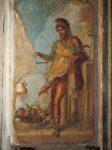 The House of the Vettii, one of the largest and richest homes in Pompeii, prodigiously endowed with a fresco of Priapus that has become an icon of the city, reopens to the public on Tuesday after years of complex restoration.
The House of the Vettii, one of the largest and richest homes in Pompeii, prodigiously endowed with a fresco of Priapus that has become an icon of the city, reopens to the public on Tuesday after years of complex restoration.
The House of the Vettii was the home of Aulus Vettius Restitutus and Aulus Vettius Conviva, freedmen brothers who made a fortune as wine merchants and ascended the social ladder. Restitutus was a candidate for aedile, a magistrate responsible for holding public games and the maintenance of public buildings. Conviva was an Augustalis, a priest of the cult of the deified Augustus, a position of civic importance that was more akin to a magistracy. In this role he would have funded major public works projects.
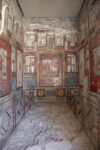 The Vettii bought the house, originally built in the 2nd century B.C., after the earthquake of 62 A.D. It was in a tony neighborhood that many of the wealthy homeowners had left rather than rebuild. When the rich moved out, the nouveau-riche moved in. Freedmen who had made big bucks in trade like the Vettii were a prime example of the trend. They bought the aristocratic villa, repaired it and expanded it, adding a huge peristyle garden with statues and fountains. Every room was lavishly painted with frescoes on mythological motifs, telegraphing their wealth and the new status it bought them. Priapus, his massive phallus balancing on a scale against a bag of money, welcomed visitors in the vestibule of the house. Two large bronze strongboxes were placed in the atrium so everyone who got past Priapus would be confronted with the the most literal possible representation of the wealth of the Vettii.
The Vettii bought the house, originally built in the 2nd century B.C., after the earthquake of 62 A.D. It was in a tony neighborhood that many of the wealthy homeowners had left rather than rebuild. When the rich moved out, the nouveau-riche moved in. Freedmen who had made big bucks in trade like the Vettii were a prime example of the trend. They bought the aristocratic villa, repaired it and expanded it, adding a huge peristyle garden with statues and fountains. Every room was lavishly painted with frescoes on mythological motifs, telegraphing their wealth and the new status it bought them. Priapus, his massive phallus balancing on a scale against a bag of money, welcomed visitors in the vestibule of the house. Two large bronze strongboxes were placed in the atrium so everyone who got past Priapus would be confronted with the the most literal possible representation of the wealth of the Vettii.
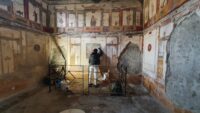 The frescoes are mostly in the Pompeiian Fourth style, a combination of the previous three styles (faux marble veneers from the first, architectural trompe l’oeil from the second, ornate, stylized ornament from the third). The Vettii frescoes provide unique insight into the transition between the Third and Fourth style of mural painting. There is also a remarkable series of striking black and red frescoes depicting groups of cupids performing a variety of tasks, mythological ones like celebrating a festival of Bacchus and a festival of Vesta, sure, but of particular note are the representations of daily work, including the gathering and pressing of grapes, buying and selling the wine, dyeing and cleaning clothes in a fullery, picking flowers and making garlands for sale, making perfumed oil and making coins. The cupids are also captured at leisure, hunting on goat-back, racing in chariots pulled by deer and taking part in an archery contest.
The frescoes are mostly in the Pompeiian Fourth style, a combination of the previous three styles (faux marble veneers from the first, architectural trompe l’oeil from the second, ornate, stylized ornament from the third). The Vettii frescoes provide unique insight into the transition between the Third and Fourth style of mural painting. There is also a remarkable series of striking black and red frescoes depicting groups of cupids performing a variety of tasks, mythological ones like celebrating a festival of Bacchus and a festival of Vesta, sure, but of particular note are the representations of daily work, including the gathering and pressing of grapes, buying and selling the wine, dyeing and cleaning clothes in a fullery, picking flowers and making garlands for sale, making perfumed oil and making coins. The cupids are also captured at leisure, hunting on goat-back, racing in chariots pulled by deer and taking part in an archery contest.
The room adjacent to the kitchen was painted with a series of explicit erotic frescoes. It may have been a visual menu of options offered by an enslaved prostitute Eutychis who advertises her services for two asses (plural of as, the lowest-value Roman coin) on a graffito at the entrance of the house.
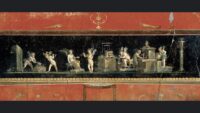 The domus was first excavated between late 1894 and early 1896. In the 1950s reinforced concrete roofs were added to the peristyle to protect the architectural remains from the elements. It was no longer protecting it, however. On the contrary, the flat concrete roof was unsound and directly contributing to water infiltration and damage.
The domus was first excavated between late 1894 and early 1896. In the 1950s reinforced concrete roofs were added to the peristyle to protect the architectural remains from the elements. It was no longer protecting it, however. On the contrary, the flat concrete roof was unsound and directly contributing to water infiltration and damage.
Already affected by works in 1995, when the problem created by the concrete roofs of the 50s was evident, the house was partially reopened in 2016, after 12 years of closure and then closed again after 3 years for further restoration. Interventions that involved the roofing but also the paintings, with the removal of the patina created by previous restorations.
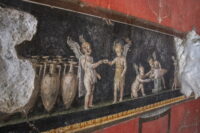 The old concrete roofs have now been replaced with sloped roofs formed from hollow blocks on metal frameworks. The wooden roofs added in the 1990s are still functional but needed refurbishment, and a new rainwater drainage system was devised to integrate the new roofs with the existing drainage system.
The old concrete roofs have now been replaced with sloped roofs formed from hollow blocks on metal frameworks. The wooden roofs added in the 1990s are still functional but needed refurbishment, and a new rainwater drainage system was devised to integrate the new roofs with the existing drainage system.
Conservators also cleaned and conserved the wall and floor decorations and the fixtures of the garden. It was a painstaking process of cleaning, regrouting and integrating interventions from different periods with the aim of recovering the legibility of the images and colors.